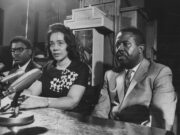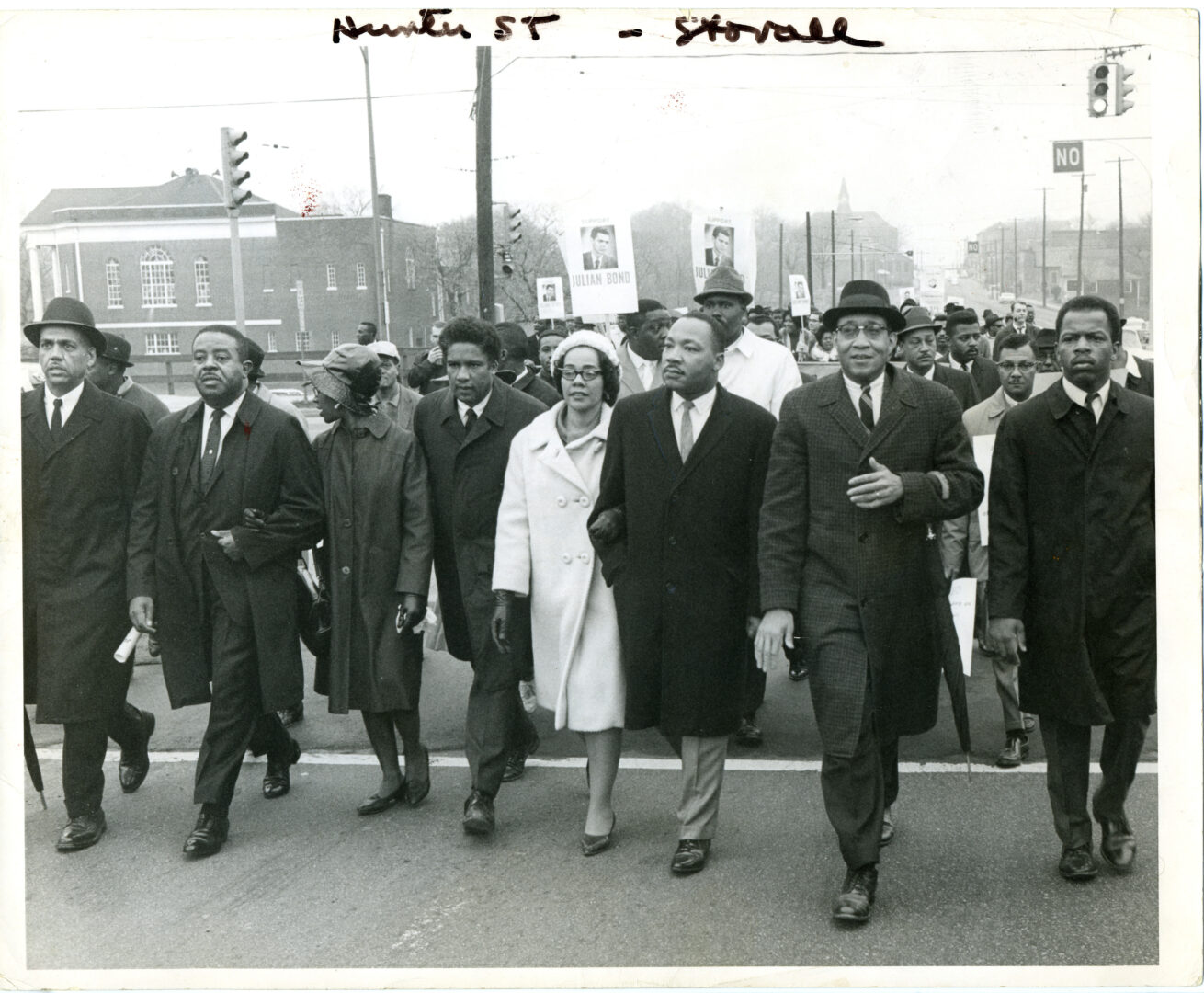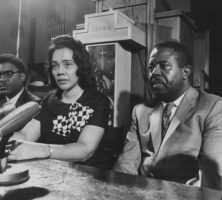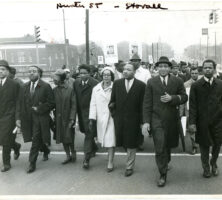As a proponent of civil and human rights, Coretta Scott King helped her husband, the Reverend Dr. Martin Luther King Jr., lead the modern civil rights movement. During their life together, she was his wife, friend, and partner, raising their four children while supporting his efforts to promote nonviolent social change in race relations during the tumultuous 1950s and 1960s. After her husband’s assassination in 1968, she articulated a vision of Kingian nonviolence expressed internationally through the Martin Luther King Jr. Center for Nonviolent Social Change that she founded in Atlanta as a memorial to her slain husband. To foster remembrance of his life and work, she advocated a federal holiday to celebrate his January birthday.
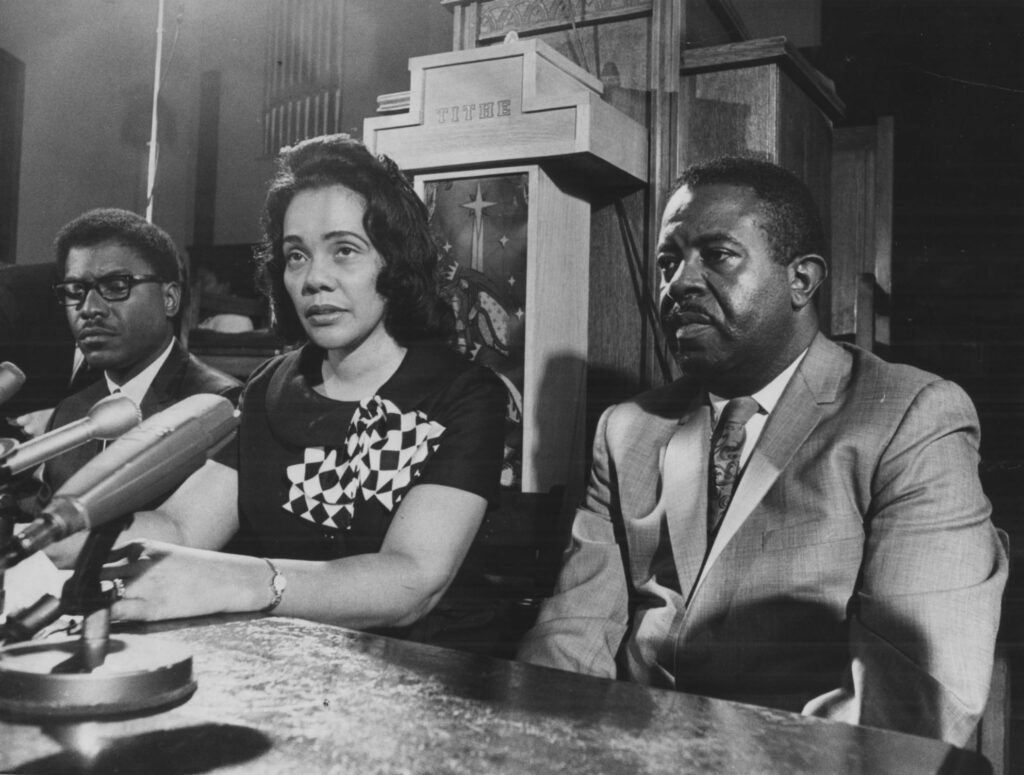
Courtesy of Atlanta Journal-Constitution.
Childhood and Education
Born on April 27, 1927, in Heiberger, Alabama, to Bernice McMurry and Obadiah Scott, Coretta grew up on her parents’ farm. Raised during the era of segregation, she attended first a rural one-room schoolhouse and then graduated from Lincoln Normal School, a private school in nearby Marion, Alabama, supported by the American Missionary Association. Her mother drove a school bus to carry the neighborhood African American children to that school.
In the late 1940s she attended Antioch College in Yellow Springs, Ohio, where she studied music education and sang with choirs at the school and in local churches. In her senior year she faced a conflict when Yellow Springs refused to allow her, as an African American practice teacher, into its white schools. Educators suggested she travel to the neighboring town and teach at the Black school. She rejected this option and decided instead to work in the integrated laboratory school on the Antioch campus. She graduated in 1951.
Her excellence as a singer earned her admission to the New England Conservatory of Music in Boston, Massachusetts, where she received a scholarship from the Smith Noyes Foundation to undertake further training. She also worked as a housekeeper and file clerk to subsidize her living expenses. After her first year at the conservatory, she received a grant from the state of Alabama to supplement the cost of her graduate education, because as an African American she had been denied access to Alabama’s public universities.
Marriage and Beginning of Civil Rights Work
In 1952 Coretta Scott met Martin Luther King Jr., who was pursuing a doctorate at Boston University. They dated for a short time and soon determined to marry. They faced some resistance from the Reverend Martin Luther King Sr. and his wife, Alberta, who had selected another woman to be their prospective daughter-in-law. However, his parents came to accept the union. They married on June 18, 1953, at the Scotts’ home, with Martin’s father as officiant.
The newlyweds returned to Boston to complete their degree requirements. The next year they moved to Montgomery, Alabama, where Martin had accepted the call to pastor Dexter Avenue Baptist Church. In spring 1955 Martin received his Ph.D. The couple’s first child, Yolanda Denise, was born November 17, 1955. Not long afterward, Martin rose to leadership in the Montgomery Improvement Association and became the spokesman for the Montgomery Bus Boycott.
Having a newborn, Coretta King stayed at home during many of the meetings and events of the Montgomery Bus Boycott. In her autobiography My Life with Martin Luther King, Jr. (1993), she recounts that the first morning of the boycott, it was she who witnessed the effectiveness of the tactic, as she looked out a window of her home and noticed the empty buses passing by. When Martin returned from mass meetings, he gave her accounts of sermons, strategies, and struggles, keeping her involved. Once arrested for violating segregation ordinances, he called her on the telephone, although others handled his release.
King and Mary Lucy Williams, another Dexter church member, were at the Kings’ house with the children on January 30, 1956, when someone threw dynamite onto the porch of the home. The blast blew out the windows and tore off the roof, and after they determined that no one was harmed, they called Ralph David Abernathy’s church, where a mass meeting was taking place, to inform Martin of what had happened. Coretta King’s father, Obadiah Scott, came from Marion and suggested strongly that she return home while the difficulties were under way. But she refused to go and remained with her husband for the rest of the civil rights struggle. As a result she sat in court with her husband when the U.S. Supreme Court ruled in November 1956 that segregation on city buses was unconstitutional.
Martin resigned as pastor of Dexter Avenue Baptist in 1960, and the couple moved to Atlanta, where he became co-pastor with his father at Ebenezer Baptist Church. Coretta King appeared by her husband’s side during his court appearances in the Albany and Birmingham, Alabama, campaigns in 1962 and 1963, respectively. She linked arms with him when marching on Washington, D.C., in 1963 and again in Selma, Alabama, in 1965. King also used her singing talents to raise money for the movement. In December 1956 she performed a concert in New York as a fundraiser for the Montgomery Improvement Association that became a model for the Freedom Concerts that later took place. King mixed narration, poetry, and music to recount the story of the boycott. She continued to perform these concerts over the rest of her life, later adapting the model for such special occasions as the annual commemorative service that takes place in Atlanta on the Martin Luther King Jr. birthday holiday.
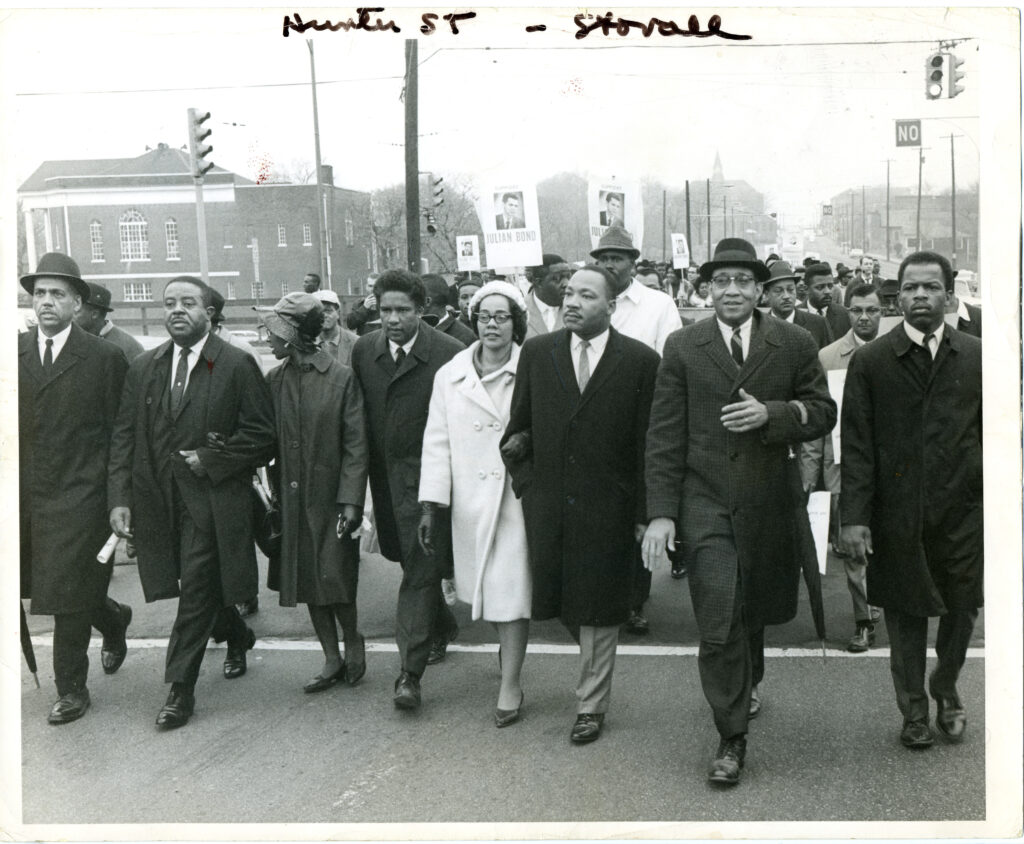
Courtesy of Atlanta Journal-Constitution.
In Coretta: The Story of Coretta Scott King (2006), Octavia Vivian, the wife of civil rights leader C. T. Vivian, notes that each of the King children was born or was very young during several early crises in the lives of the Kings. Yolanda was a newborn at the time of the Montgomery Bus Boycott. Martin Luther III was born October 23, 1957, and was only a year old when his father was stabbed in New York City by Izola Ware Curry, a mentally ill woman. King was pregnant with Dexter Scott when her husband was imprisoned at the Georgia State Penitentiary in Reidsville in 1960. Bernice Albertine was born on March 28, 1963, shortly before her father was jailed in Birmingham. Throughout, King remained primarily behind the scenes, stepping into the spotlight on occasion, a few times because of high-profile phone calls. John F. Kennedy called her during the 1961 presidential race, when DeKalb County officials had locked up her husband in the Decatur prison. Later, as president, Kennedy called her again when Martin was in the Birmingham prison; U.S. attorney general Robert Kennedy gave King a phone call during this time as well.
Coretta’s commitment to nonviolence and the movement also led her on international trips. In 1957 she and her husband traveled to Ghana to mark the country’s independence from Great Britain, as it was the first African colony to gain its freedom. In 1959 the couple took a pilgrimage to sites related to Mahatma Gandhi, a practitioner of civil disobedience and leader of the independence struggle in India. In 1962 King traveled to Switzerland to serve as a delegate to Women Strike for Peace, a seventeen-nation conference on disarmament. She accompanied her husband to Norway in 1964, when he received the Nobel Peace Prize.
On April 4, 1968, King’s husband was assassinated by James Earl Ray in Memphis, Tennessee. King traveled immediately to Memphis, before her husband’s funeral, to march with the striking sanitation workers whose campaign for living wages her husband had championed before his murder. King soon became an icon for the image of strength that she maintained throughout this difficult time, and she was often compared to former first lady Jacqueline Kennedy, who likewise had suffered in the public’s eye the assassination of her husband.
Carrying Forth the Legacy
King picked up her husband’s leadership role in the Poor People’s Campaign of the Southern Christian Leadership Conference (SCLC) and spoke for him at the March on Washington in June 1968. She called upon American women “to unite and form a solid block of women power to fight the three great evils of racism, poverty, and war.” While this call was certainly in line with the philosophy of Kingian nonviolence, it marked a departure by emphasizing the role of women in a movement primarily led by men. Soon thereafter, she clashed with the male leaders of the SCLC when she announced plans to build the King Center and to establish the Martin Luther King Jr. birthday holiday. Nonetheless, thanks to her efforts and her success in fund-raising, the King Center opened in 1982. Today it is part of a complex that includes a visitors’ center, Martin Luther King Jr.’s birth home, Ebenezer Baptist Church, and the burial places of both King and her husband.
The Martin Luther King Jr. holiday effort took almost twenty years to bring to fruition and is perhaps Coretta King’s greatest achievement. After some lobbying by the King family and other supporters, Congress approved the holiday in 1983, and the first holiday was observed in 1986. While many states observed the date designated as a federal holiday, some states, such as Arizona, refused to recognize the holiday. In 1999 New Hampshire became the final state to formally adopt the holiday.
Throughout the remainder of her life, King remained active in domestic as well as international political and social justice efforts. She worked with the National Organization for Women on the Equal Rights Amendment, and she advocated affirmative action. During the 1970s, she protested in Boston in favor of busing. In the 1980s she worked with anti-apartheid groups and was arrested with her children Bernice and Martin III during a protest in front of the South African embassy in Washington, D.C. She established a friendship with Winnie and Nelson Mandela and attended his inauguration as president of South Africa in 1994. An annual program of the King Center, offered in conjunction with the King Holiday observance, was her “State of the Dream” speech, which surveyed gains and challenges to domestic and international human rights issues.
King also worked to preserve and catalog her husband’s papers. In 1985 she initiated the Martin Luther King Jr. Papers Project, headed by historian Clayborne Carson of Stanford University in Stanford, California. As of 2007 the project had published six volumes of Martin’s writings.
King engaged in other activities to maintain her husband’s legacy that proved more controversial. In 1987 she unsuccessfully sued Boston University, demanding the return of a collection of documents that Martin had deposited there prior to his death. She wanted these materials to be part of a research collection at the King Center. In 1996 the King estate challenged the right of CBS Television to use and license footage that CBS shot of the 1963 March on Washington, including the “I Have a Dream” speech. The case settled in 2000 for an undisclosed amount of money and for CBS’s right to use the footage in its own productions.
King also encouraged a reopening of an investigation into her husband’s assassination, speaking out publicly about her doubts that James Earl Ray was the only gunman and that he acted alone. After Ray’s death in 1998, the King estate filed a wrongful death suit against Loyd Jowers, who had been the owner and operator of Jim’s Grill, near the Lorraine Motel, the site of the assassination. The suit asked for only $100 in damages, but its larger purpose was to enter into the public record testimony from Jowers that would reveal a conspiracy around Martin’s assassination. Over the years Jowers had told journalists that his restaurant had been a staging area for the assassination and that the assassin was not Ray, although some experts doubted the veracity of his claims. Jowers’s statements were entered into the record via two depositions, in which he asserted that Ray did not shoot Martin Luther King Jr. and that there had been a conspiracy surrounding the murder. He did not, however, name any of the other conspirators.
King herself took the witness stand, as did a number of other civil rights movement participants. Jowers did not appear in person during the trial, but based on his deposition testimony, a jury convicted him of involvement in a conspiracy, which led the U.S. Justice Department to undertake a limited examination of the new evidence that this trial brought forward. The King family made a statement calling for the case to be reopened, yet historians and the general public did not accept the conspiracy concept as fact.
Death and Impact
King died at a holistic health hospital in Mexico on January 30, 2006, after suffering a stroke in August 2005. She made her last public appearance at the Martin Luther King Jr. Day “Salute to Greatness” dinner on January 14 but did not address the audience. After her death, her family disclosed that she had suffered from ovarian cancer.
Georgia governor Sonny Perdue arranged for King to be the first woman and first African American to lie in state at the state capitol rotunda. A second viewing took place at Ebenezer Baptist Church, where her husband’s funeral had taken place decades before. There, tens of thousands of people viewed her body and attended a memorial service. King’s funeral was held at New Birth Missionary Baptist Church, a “megachurch” where her daughter Bernice, an ordained minister, has been an elder. The service lasted six hours and included tributes from four presidents of the United States, other elected officials, entertainers, civil rights movement veterans, and international human rights activists.
King was initially buried at the King Center in a site near her husband’s crypt. In November 2006 the couple was laid to rest together in an enlarged crypt, located in the middle of the reflecting pool at the King Center.


